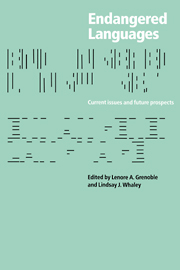Book contents
- Frontmatter
- Contents
- Preface
- List of abbreviations and symbols
- Part I General issues
- Part II Language-community responses
- 3 Technical, emotional, and ideological issues in reversing language shift: examples from Southeast Alaska
- 4 Mayan efforts toward language preservation
- 5 A chronology of Mohawk language instruction at Kahnawà:ke
- 6 Language endangerment in South America: a programmatic approach
- Part III What is lost: language diversity
- Part IV Mechanisms of language loss
- Appendix
- References
- Index of languages
- Index of names
- General index
4 - Mayan efforts toward language preservation
Published online by Cambridge University Press: 05 June 2012
- Frontmatter
- Contents
- Preface
- List of abbreviations and symbols
- Part I General issues
- Part II Language-community responses
- 3 Technical, emotional, and ideological issues in reversing language shift: examples from Southeast Alaska
- 4 Mayan efforts toward language preservation
- 5 A chronology of Mohawk language instruction at Kahnawà:ke
- 6 Language endangerment in South America: a programmatic approach
- Part III What is lost: language diversity
- Part IV Mechanisms of language loss
- Appendix
- References
- Index of languages
- Index of names
- General index
Summary
Introduction
Mayan languages are among the most vigorous of indigenous American languages. They are spoken by over 6 million people in Guatemala alone (Tzian 1994), with significantly large numbers of speakers in southern and central Mexico (Chiapas, Tabasco, Campeche, Yucatán and Quintana Roo, San Luís Potosí, and Veracruz) and Belize. Although Mayas suffered great losses of population and territory as a result of the Spanish invasion of the sixteenth century, their population has, largely recovered, and they form absolute majorities in almost all of the communities where they presently live. The great majority of Mayas speak one of the twenty-nine extant Mayan languages, almost always as a first language, and many Mayas are monolingual in a Mayan language, especially among the older population. In spite of these demographic signs of vitality, however, language shift and loss among Mayas is growing at an alarming rate, and Mayan community leaders are increasingly concerned about the future viability of their languages and community structures.
Because of the strengthening of signs of language shift, especially in, but not restricted to, the smaller language communities, Mayan languages must certainly be counted among the world's endangered languages. Mayas in Guatemala have begun to take steps to fortify their language and try to prevent language loss on a grand scale. Whether these efforts will ultimately be successful is of course still unclear, but it may be instructive to examine the measures that are being proposed and followed in a situation where language shift and loss is still in its earlier rather than final stages.
- Type
- Chapter
- Information
- Endangered LanguagesLanguage Loss and Community Response, pp. 99 - 116Publisher: Cambridge University PressPrint publication year: 1998
- 10
- Cited by

